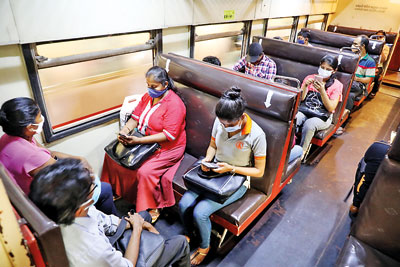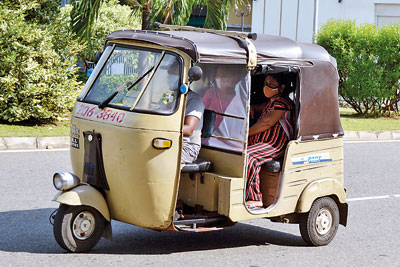News
Normalcy with restrictions has some people confused
As Colombo and Gampaha districts open up after nearly two months, workers who live in out stations reluctant to return fearing lack of lodging facilities and contracting COVID-19, say employers
Some point out current ban on travel between the Colombo and Gampaha districts is “illogical and impractical”
The country’s gradual return to normalcy in the post-COVID-19 era took another step forward this week as curfew throughout the island was relaxed for the first time in more than two months, enabling citizens to finally go about their daily lives while adhering to the health and safety guidelines put in place by authorities.
The week was also immensely significant for the Colombo and Gampaha districts as authorities finally relaxed an indefinite curfew that had been in place in these districts since March. While the first stage of the Government’s resumption of civilian life and work in these districts began on May 11 while curfew was still in effect, normalcy was further restored with the lifting of curfew during the day from last Tuesday (26).
Even though curfew was finally lifted, there were still many restrictions in place to prevent the spread of COVID-19. Health authorities continue to insist that state and private sector institutions should only ask the minimum number of employees needed to run the organization on a day-to-day basis to report to work. In most state sector institutions in the Colombo district, only ⅓ of the workforce is reporting to work. The heads of both public and private sector organisations have been given the responsibility to decide on the numbers and personnel they call into work.

Though they have opened, many bakeries in the Colombo and Gampaha districts are experiencing a shortage of staff
Bakeries
With an island-wide curfew only in place from 10 p.m. to 4 a.m. daily, many sectors which had remained closed or had operated at minimal capacity recommenced work this week. Most bakeries in the Colombo and Gampaha districts, for example, only started operating from Tuesday. N.K. Jayawardena – President Bakery Owners’ Association estimated that about 90% of bakeries were now open.
Though they have opened, many bakeries in the Colombo and Gampaha districts are experiencing a shortage of staff, Mr Jayawardena revealed. “This is mainly because of the restrictions still in place regarding travel between these two districts. The vast majority of our bakery staff reside outside these districts. Many are from far off places such as Nuwara Eliya, Badulla and Bandarawela. They are fearful of returning on account of questions over whether they will be allowed to cross into these districts, lack of public transport and uncertainty over whether they can find boarding places,” he explained.
Mr Jayawardena opined that the current ban on travel between the Colombo and Gampaha districts was “illogical and impractical.”
“For example, a person who travels on a bus from Kandy can get down at Nittambuwa and hop on another bus to Colombo. Who is going to stop them? It’s just a matter of changing buses. It may be a bit of a nuisance to the passenger, but we know it’s happening.”
Construction industry
The construction industry too is starting to resume work once more in the Colombo district, though there are still a host of issues that need to be sorted out. “About 80% of our clients are in the state sector. They are supposed to be running on ⅓ of their workforce but in reality, the number of employees currently in state offices are even less,” said M.G.K. Karunawansa, Chairman (Western Branch) of the National Construction Association of Sri Lanka (NCASL). “Clients are required to conduct inspections, pass funds for the projects and approve various construction related matters. To do that, they need people in their offices. Yet, when we have visited state sector offices, there are very few staff in attendance. In many cases, there are far less present than the ⅓ they can get down to work. Most staff in state offices still work from home and those who do report to work come in late and leave early. They don’t have enough personnel to look into our projects so nothing much gets done.”
Mr Karunawansa, who represents small and medium construction industries, added that they themselves only have a limited number of workers at their construction sites due to restrictions imposed by health authorities. “We can manage, but this is an issue in large sites where hundreds of workers are employed. It’s very difficult to manage a site that usually has 100 workers with just 25. Productivity goes down and we can’t meet the contract deadlines.”
Many construction workers too, reside in far off villages outside the Western province. Many are from villages in the upcountry and the Northern, Eastern and Southern provinces. Some have been stuck in Colombo for almost two months and have only just got back to their villages through state assistance. “They have issues such as whether there will be enough buses now to come back to Colombo and whether they can find boarding places. Some think they need permission from Grama Niladharis or PHIs to return to work. We have sent letters or text and WhatsApp messages to them to show police when they are coming as proof that they have been called in to work,” he explained.
Mr Karunawansa said the Government’s messages for those coming in to work were not clear enough. People are confused by a lot of things, and there is also real apprehension among those based in far flung villages that they could become infected with COVID-19 by working in Colombo and then carry it to their villages. “I haven’t seen a concerted effort from authorities yet to allay these fears.”
He added that they were in talks with the Construction Industry Development Authority to find solutions to the problems they are currently faced with.
Salons and tourism industry
Meanwhile, salons are still only conducting a limited number of services with about 50% of staff. “We are conducting less than 50% of our services still and all our clients come by prior appointment,” said Nayana Karunaratne, President of Sri Lanka Association of Hairdressers and Beauticians.
While working in masks, wearing face shields and other gear required under the new guidelines can get uncomfortable, Ms Karunaratne said they had no complaints. “We are working. It’s better than nothing.” She also pointed out that the equipment and strict guidelines were necessary for salons as this was a trade where social distancing cannot be practiced between them and the customer.
Efforts to revive the tourism industry, which was among the most severely hit by the pandemic, have also commenced. As a first step, the Government allowed hotels and restaurants registered under the Sri Lanka Tourism Development Authority (SLTDA) to open from Wednesday (27) for in-house dining. Depending on its progress, the Government hopes to open unregistered eateries later on.

Construction sites have a limited number of workers due to restrictions imposed by health authorities. Pix by Sameera Weerasekera
Sri Lanka Tourism Chairperson Kimarli Fernando said the hotels and restaurants are being opened for in-house dining and local guests as the industry gradually opens for domestic tourism. The next target is to open the country up to foreign tourists from August 1, she noted. Meanwhile, hotels are also being allowed to open their banquet halls for weddings and other functions provided they strictly adhere to health sector guidelines. Key guidelines include ensuring a 1.5 metre distance among guests, limiting the seating capacity to ⅓ of the hall and only allowing a maximum of 100 guests inside the hall.
While restaurants in hotels will be open, other hotel facilities such as spas, gyms and swimming pools will continue to be closed, Ms Fernando stressed.
Railways
Meanwhile, transport for those coming into work has further improved, according to authorities. Sri Lanka Railways (SLR) started operating 27 trains this week for those reporting to work. They were operated on five lines, namely, Main Line, Coastal Line, Kelani Valley line, Puttalam Line and Northern Line. A further two trains were added later between Beliatta to Colombo and Kandy to Colombo.
There were more than enough trains to accommodate the number of passengers, Deputy General Manager of Railways Vajira Polwattage assured. “We had a seating capacity of 18, 000 in the trains operated on Wednesday, but only 15, 901 passengers took the train,” he said.
While trains are still only reserved for those commuting to work, Mr Polwattage said there have been instances where some had attempted to travel by train for personal journeys, which is still not allowed. “The other issue is that passengers don’t wait for their allocated train, but try to board the first train that pulls up at the station. The system of assigning trains to each individual is to make contact tracing easier. Overcrowding a train increases the risk of the virus spreading to people and also makes contact tracing difficult, which is why we are appealing to commuters to exercise discipline and to wait for their assigned train,” he emphasized.

Sri Lanka Railways (SLR) started operating 27 trains this week for those reporting to work. Pic by M.A. Pushpa Kumara
| New guidelines in motion The Health Ministry also issued an updated set of guidelines this week for 46 different work settings and public activities. Titled, “Towards a New Normal,” the guidelines cover a range of measures that should be practiced as the country gradually moves out of the lockdown imposed owing to COVID-19. The guidelines themselves cover a range of areas such as transport, recreation, religious activities, social functions and shopping. Some of the guidelines are already being enforced. For example, three-wheelers are keeping the maximum number of adult passengers to two and are also installing a transparent barrier between the driver and passenger.  Some three wheelers have installed transparent barrier between the driver and passenger. Pic by M.D. Nissanka | |


